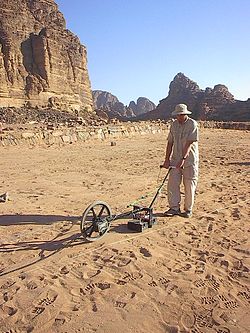All Categories
Featured
Table of Contents
Geophysical Surveys As Landscape Archaeology in Coogee Western Australia 2021
Much of the image includes blank areas now with little or no radar response. The "yard" wall is still showing strongly, however, and there are continuing recommendations of a hard surface area in the SE corner. Time piece from 23 to 25ns. This last slice is now practically all blank, but a few of the walls are still revealing highly.
How deep are these pieces? The software application I have access to makes estimating the depth a little challenging. If, however, the leading 3 pieces represent the ploughsoil, which is most likely about 30cm think, I would think that each slice has to do with 10cm and we are only getting down about 80cm in total.

Fortunately for us, the majority of the websites we are interested in lie just listed below the plough zone, so it'll do! How does this compare to the other methods? Contrast of the Earth Resistance information (leading left), the magnetometry (bottom left), the 1517ns time piece (top right) and the 1921ns time slice (bottom left).
Geophysical Survey - Explore The Seafloor in Lynwood Aus 2021
Magnetometry, as talked about above, is a passive method determining local variations in magnetism against a localised absolutely no value. Magnetic vulnerability survey is an active strategy: it is a step of how magnetic a sample of sediment could be in the presence of an electromagnetic field. How much soil is tested depends upon the size of the test coil: it can be very little or it can be relatively large.
The sensing unit in this case is really little and samples a tiny sample of soil. The Bartington magnetic susceptibility meter with a large "field coil" in use at Verulamium during the course in 2013. Leading soil will be magnetically enhanced compared to subsoils merely due to natural oxidation and decrease.
By determining magnetic vulnerability at a relatively coarse scale, we can find areas of human profession and middens. Regrettably, we do not have access to a trusted mag sus meter, however Jarrod Burks (who assisted teach at the course in 2013) has some exceptional examples. One of which is the Wildcat website in Ohio.
Airborne Geophysical Surveys Of The Lower Mississippi ... in Ellenbrook Aus 2020
These villages are frequently laid out around a main open location or plaza, such as this rebuilt example at Sunwatch, Dayton, Ohio. Sunwatch Town, Dayton, Ohio (image: Jarrod Burks). At the Wildcat site, the magnetometer study had found a range of features and homes. The magnetic susceptibility survey helped, however, define the primary area of occupation and midden which surrounded the more open location.
Jarrod Burks' magnetic vulnerability study arises from the Wildcat website, Ohio. Red is high, blue is low. The strategy is for that reason of fantastic use in defining locations of basic profession instead of determining specific features.
Geophysical surveying is a used branch of geophysics, which uses seismic, gravitational, magnetic, electrical and electromagnetic physical approaches at the Earth's surface to determine the physical homes of the subsurface - Geophysical Survey Llc - Home in Kenwick Australia 2020. Geophysical surveying techniques normally measure these geophysical homes in addition to abnormalities in order to examine various subsurface conditions such as the presence of groundwater, bedrock, minerals, oil and gas, geothermal resources, voids and cavities, and far more.
Latest Posts
Geophysicist Jobs in North Perth Australia 2021
Geophysical Survey Definition in Warnbro Western Australia 2021
What Is Geophysics? in Carlisle Australia 2020